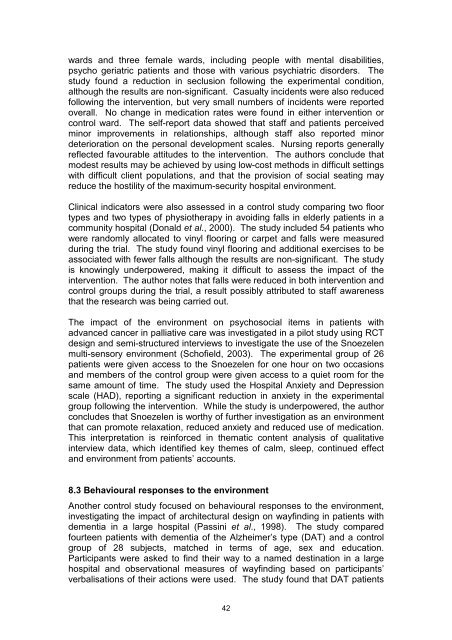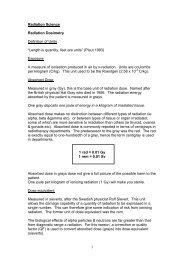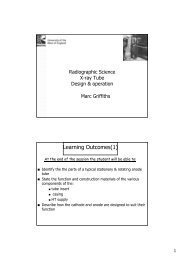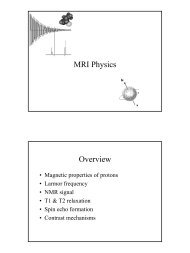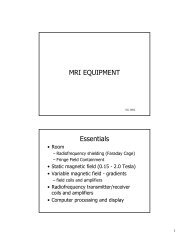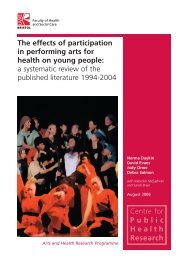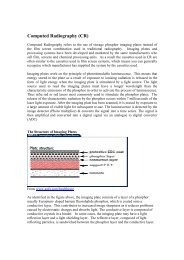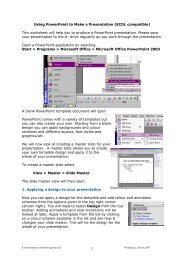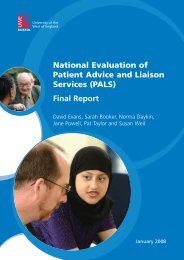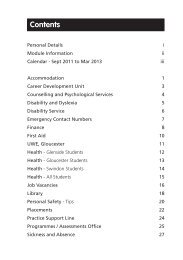Literature Review - HSC Home - University of the West of England
Literature Review - HSC Home - University of the West of England
Literature Review - HSC Home - University of the West of England
Create successful ePaper yourself
Turn your PDF publications into a flip-book with our unique Google optimized e-Paper software.
wards and three female wards, including people with mental disabilities,psycho geriatric patients and those with various psychiatric disorders. Thestudy found a reduction in seclusion following <strong>the</strong> experimental condition,although <strong>the</strong> results are non-significant. Casualty incidents were also reducedfollowing <strong>the</strong> intervention, but very small numbers <strong>of</strong> incidents were reportedoverall. No change in medication rates were found in ei<strong>the</strong>r intervention orcontrol ward. The self-report data showed that staff and patients perceivedminor improvements in relationships, although staff also reported minordeterioration on <strong>the</strong> personal development scales. Nursing reports generallyreflected favourable attitudes to <strong>the</strong> intervention. The authors conclude thatmodest results may be achieved by using low-cost methods in difficult settingswith difficult client populations, and that <strong>the</strong> provision <strong>of</strong> social seating mayreduce <strong>the</strong> hostility <strong>of</strong> <strong>the</strong> maximum-security hospital environment.Clinical indicators were also assessed in a control study comparing two floortypes and two types <strong>of</strong> physio<strong>the</strong>rapy in avoiding falls in elderly patients in acommunity hospital (Donald et al., 2000). The study included 54 patients whowere randomly allocated to vinyl flooring or carpet and falls were measuredduring <strong>the</strong> trial. The study found vinyl flooring and additional exercises to beassociated with fewer falls although <strong>the</strong> results are non-significant. The studyis knowingly underpowered, making it difficult to assess <strong>the</strong> impact <strong>of</strong> <strong>the</strong>intervention. The author notes that falls were reduced in both intervention andcontrol groups during <strong>the</strong> trial, a result possibly attributed to staff awarenessthat <strong>the</strong> research was being carried out.The impact <strong>of</strong> <strong>the</strong> environment on psychosocial items in patients withadvanced cancer in palliative care was investigated in a pilot study using RCTdesign and semi-structured interviews to investigate <strong>the</strong> use <strong>of</strong> <strong>the</strong> Snoezelenmulti-sensory environment (Sch<strong>of</strong>ield, 2003). The experimental group <strong>of</strong> 26patients were given access to <strong>the</strong> Snoezelen for one hour on two occasionsand members <strong>of</strong> <strong>the</strong> control group were given access to a quiet room for <strong>the</strong>same amount <strong>of</strong> time. The study used <strong>the</strong> Hospital Anxiety and Depressionscale (HAD), reporting a significant reduction in anxiety in <strong>the</strong> experimentalgroup following <strong>the</strong> intervention. While <strong>the</strong> study is underpowered, <strong>the</strong> authorconcludes that Snoezelen is worthy <strong>of</strong> fur<strong>the</strong>r investigation as an environmentthat can promote relaxation, reduced anxiety and reduced use <strong>of</strong> medication.This interpretation is reinforced in <strong>the</strong>matic content analysis <strong>of</strong> qualitativeinterview data, which identified key <strong>the</strong>mes <strong>of</strong> calm, sleep, continued effectand environment from patients’ accounts.8.3 Behavioural responses to <strong>the</strong> environmentAno<strong>the</strong>r control study focused on behavioural responses to <strong>the</strong> environment,investigating <strong>the</strong> impact <strong>of</strong> architectural design on wayfinding in patients withdementia in a large hospital (Passini et al., 1998). The study comparedfourteen patients with dementia <strong>of</strong> <strong>the</strong> Alzheimer’s type (DAT) and a controlgroup <strong>of</strong> 28 subjects, matched in terms <strong>of</strong> age, sex and education.Participants were asked to find <strong>the</strong>ir way to a named destination in a largehospital and observational measures <strong>of</strong> wayfinding based on participants’verbalisations <strong>of</strong> <strong>the</strong>ir actions were used. The study found that DAT patients42


